introduction
How might we analyze a website, book, or movie? We can accomplish this through a rhetorical analysis, which according to Writer/Designer is “a method of describing the context in which an author wants to communicate his or her purpose/call to action to the intended audience in a genre” (Arola, Sheppard, Ball 22). To understand this analysis, I have analyzed Lutheran Immigration and Refugee Services’ (LIRS) website. I have found through my analysis that LIRS has a seemingly strong sense of what their purpose, author(s), audience, genre, and context are.
Audience
First, to begin to understand what this website is trying to accomplish, we must contemplate who the intended audience is. According to Writer/Designer Chapter 2, “The audience is the intended readership for the text” (Arola, Sheppard, Ball 22). LIRS is a non-profit organization, where the organization’s income only goes directly to supporting the mission. We can consider that the people that donate are the primary audience of this website. Here you can see “DONATE” is in a different color and your attention is directly drawn to it from the very first page without scrolling (aka the landing page).
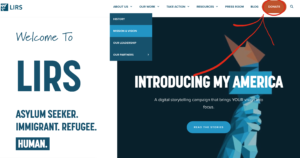
The secondary audience could be considered to be religious people (specifically Lutheran) and most likely people who are wealthy (aka wealthy Lutherans). When trying to reach the secondary audience, a non-profit should make it easily accessible to learn more about the organization. This website accomplishes reaching their primary audiences and their secondary audiences well by making the landing page include a donate option as well as the “INTRODUCING MY AMERICA” where I can easily learn more about the recipients of LIRS. 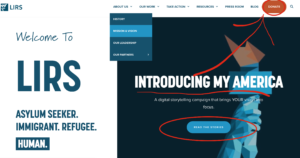 If I learn more, I’m more likely to donate. This also supports the values that the audiences might have. If I was a donor, I would like to know my money is going to actually help and support the mission. By clicking “read more stories,” I now have access to read about people who have actually received the service of LIRS.
If I learn more, I’m more likely to donate. This also supports the values that the audiences might have. If I was a donor, I would like to know my money is going to actually help and support the mission. By clicking “read more stories,” I now have access to read about people who have actually received the service of LIRS.
Author
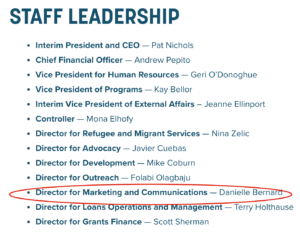
But who is behind lirs.org? Considering the author, it can be quite clear or we will have to make an informed guess (Arola, Sheppard, Ball 25). First, the non-profit organization should make their mission and who they are clear. LIRS makes this very specific and understandable after clicking “about us” and “mission & vision.” However, after clicking the “about us” and “our leadership” you can see the Marketing and Communications is Danielle Bernard:
I couldn’t specifically find out whether or not Danielle Bernard is a credible source. But maybe in the case of LIRS it doesn’t matter. LIRS website’s accomplishes reaching their primary and secondary audiences well. The author can also be interpreted as being the people that have been supported by LIRS through reading stories here on My America:
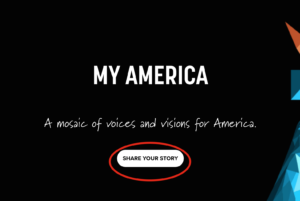
Genre
The genre of this website is geared as a non-profit organization. According to Wikipedia, the key aspects the audience expects from a non-profit organization are “accountability, trustworthiness, honesty, and openness to every person who has invested time, money, and faith into the organization” (Wikipedia, Nonprofit Organization). Just like we expect certain things from a horror movie or a newspaper, we expect a non-profit organization’s website to be accountable, trustworthy, honest, and open. I believe that is why LIRS almost always uses the color blue, which can signify trust, honesty, and faith.
The website accomplishes this also with the stories that are shared by those helped by LIRS:
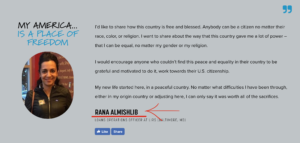
Here you can see that Rana Almishlib is a real person. This demonstrates LIRS as being honest and accountable. This one story is an example of many LIRS has shared.
context
Now, we must consider the context. We must think about the where, how, and what (Arola, Sheppard, Ball 24) of the website. The what is a website and how is using the Web to access it. When I searched in google “immigration and services,” lirs.org was the second option: 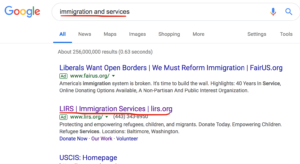
This can be seen as where many people can gain access to this website.
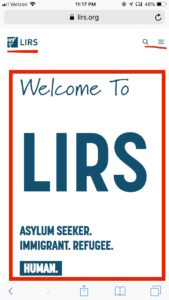
Also, on my iPhone, I found that the landing page is evenly spaced and organized. However, the “DONATE” button is removed. This shows how the context is different on our mobile devices and not as blatantly geared towards donors. Overall the website is easily accessible.
purpose
With all this in mind, what can we say is the purpose of this website? Writer/Designer explains that purpose can have a wide range of possible intentions (Arola, Sheppard, Ball 23). We must consider the primary purpose as well as the secondary purpose. The primary purpose is to gain support for the website, as we have already seen by LIRS targeting donors and supporters as their primary audience. However, the secondary purpose may be to demonstrate LIRS credibility. I saw it here, through them telling me simply how long they have been around, how many volunteers there are, how many partners, and how many immigrants they have welcomed: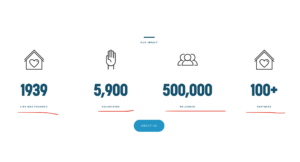
conclusion
I found LIRS’s website to be what you should expect from a well designed non-profit organization’s website. The purpose and audience are well established through the website’s use of placement of buttons and usage of colors. Like anyone and everything, there are always ways it can improve. For LIRS, the website could have more stories from the people supported by LIRS to make my trust in them more well-rounded. I also will say that on the landing page, LIRS could add in a GIF/video to immediately get my attention. This GIF/video should be designed to touch the emotions of the primary and secondary audiences. However, with that being said, by analyzing LIRS one can understand what makes a excellent and well-thought out non-profit website.
references
Arola, Sheppard, & Ball. Writer/Designer: A Guide to Making Multimodal Projects. Boston, Bedford/St. Martin’s, 2014.
Wikipedia contributors. “Nonprofit organization.” Wikipedia, The Free Encyclopedia. Wikipedia, The Free Encyclopedia, 2 Feb. 2019. Web. 7 Feb. 2019.